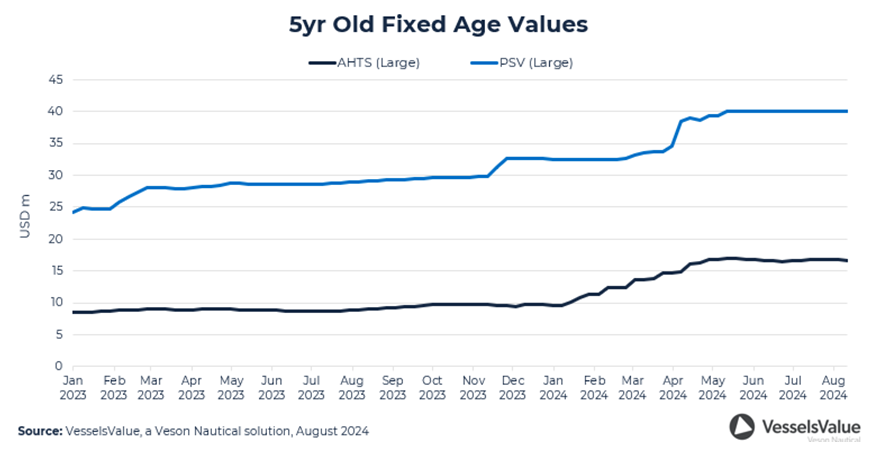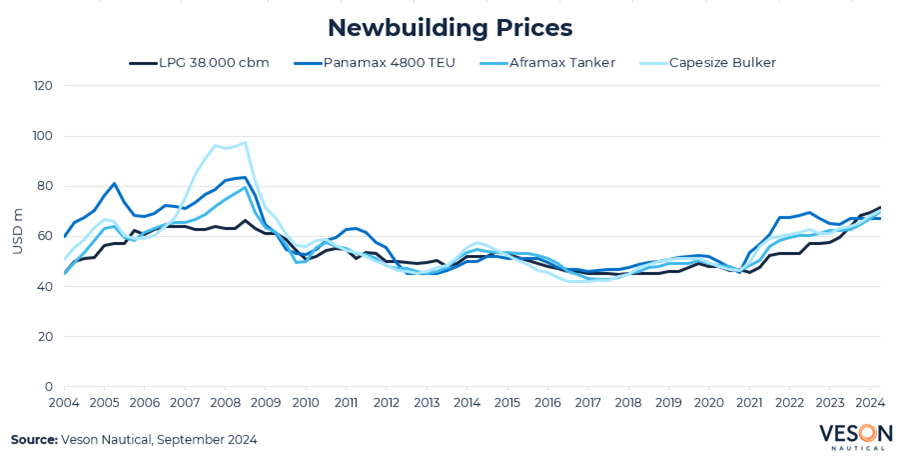Greek ship owners have spent an unprecedented US$18 billion on newbuild gas vessels since 2021 as companies diversify their portfolios away from traditional tanker, bulker and container asset classes, according to new research by VesselsValue, the data intelligence arm of maritime data and freight management solutions provider Veson Nautical.
A new report “Greek Speculative S&P Investments” states that around US$13.8 billion of the figure has been spent on 59 liquefied natural gas (LNG) vessels, and around US$4 billion on 41 liquid petroleum gas (LPG) vessels.
This compares to Greek ship owners spending approximately US$12.2 billion on 167 tanker vessels, around $US4.1 billion on 109 bulkers, and around US$3.1 billion on 39 container ships.

“In a decade defined by volatile markets and seismic shifts in shipping dynamics, Greek ship owners have taken bold investment stances that could shape the future of global trade,” says Dan Nash, Associate Director of Valuation & Analytics at VesselsValue. “Greek ship owners are clearly planning for future increases in gas and LNG supply in the global energy mix with these speculative investments.”
Capital leading the way
The report names the Piraeus-based Capital Ship Management (Capital) the most speculative with 15 large LNG vessels, two very large ammonia carriers (VLAC), eight medium gas carriers (MGC), and four carbon dioxide (CO2) vessels for a combined spend of approximately US$4.7 billion.
Capital is followed by the Athens-based Maran Gas Maritime (Maran), the LNG ship management company of the Angelicoussis Shipping Group, with a total spend of around US$3.3 billion including 15 large LNG carriers.
The Athens-based Evalend Shipping is third, spending about US$3 billion on 12 very large gas carriers (VLGC), two MGC’s, two VLAC’s and six large LNG vessels.

Offshore oil & gas market attracting interest
The report adds that offshore values for five-year-old, large anchor handling tug supply (AHTS) vessels, which are used to anchor and secure oil and gas platforms have spiked by 97% since 2021. Platform supply vessels (PSV’s) have spiked by 67%. Prices have been supported by a low orderbook of between 2% and 3%.
The rise in values prompted Capital to pay US$180 million for four PSV units to China’s Fujian Mawei Shipbuilding in June with repeat options. This was swiftly followed by two medium PSV orders.
“Vessel prices in the offshore market have risen by a huge margin since 2021, but Capital is clearly anticipating a strong forward curve going forward,” Nash pointed out.

Newbuild prices to remain high across all asset classes
The report indicated that newbuilding prices across sectors have reached their highest level since the 2008 financial crisis with the most recent upward pressure commencing in 2021. The high ordering activity for container and LNG vessels in 2021/22 has exerted even more pressure on shipyard capacity and building periods. Due to the increase in orders, shipyards have held the upper hand in price negotiations and prices have climbed.
“Whilst we do not foresee a repeat of the ordering volumes from the pandemic years, we expect to see newbuilding prices for container vessels rising above the upward trendline of other sectors,” notes Nash, adding that expectations are for Container newbuilding prices to continue to rise in 2024 and into 2025 at a higher pace than that of the other sectors.
Unless container vessel earnings continue to increase, container ordering demand is expected to slow and the total orderbook to slowly subside, according to Nash, who concluded, “If sustained over some time, a declining total orderbook will remove capacity pressure from shipyards which typically leads to lower newbuilding prices. However, this decline will be gradual and is probably 12-24 months out in time, therefore vessel prices are expected to remain in historically high territory.”







